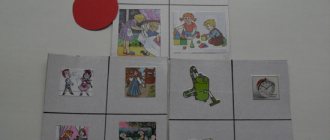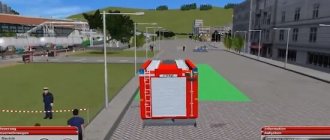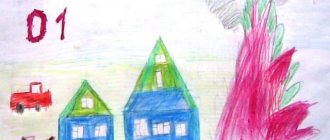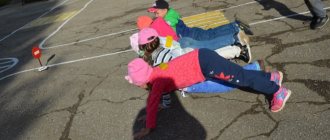Publications about the preparation and conduct of classes on fire safety. We strengthen children's knowledge about the causes of fires, safety rules at home and on the street. We form ideas about the benefits and harms of fire. We teach children to find the right way out of dangerous situations. We systematize their knowledge about what burns and what doesn’t burn. We make children want to be careful with fire always and everywhere. We cultivate responsibility for ourselves and for the lives of our loved ones. See what ways your colleagues have found to present material on fire safety in an entertaining way.
Fire safety rules for children
Every year, children under fourteen years of age are killed or seriously injured in fires and fires. The main reason can be called the dishonesty of parents, as well as the lack of knowledge and skills to behave in case of fire. To prevent fire safety, it is necessary to conduct lessons, conversations, and lectures.
It is recommended to consolidate the result with the help of games that help update the information received. Cartoons developed with the support of the Fire Service will help explain fire safety rules to young children (“Fire in the forest”, “Fire in the apartment”, “Rules of behavior for children in case of fire”).
Fire safety rules will be explained during life safety lessons, as well as during class hours on this topic. The use of poems by S. Marshak “Very, very important rules!”, “Song of Matches”, A. Usachev “Fire”, E. Gladkova “If there is a fire in the house” and others will help in this.
Basic fire safety rules for children
- You cannot play with matches, lighters, or match-candles;
- You cannot set fire to dry leaves, dry grass, trees, or poplar fluff;
- You cannot play with fireworks, sparklers, or firecrackers without adult supervision;
- You cannot use gasoline, kerosene and other flammable materials for gaming purposes;
- Do not throw bottles of deodorants, perfumes, air fresheners, etc. into a fire or set fire to them. This may result in an explosion and immediate fire;
- You cannot make a fire or play with an open fire indoors;
- You cannot make a fire in wooden sheds, dilapidated buildings, basements and attics;
- if there is a need for light, it is better to use a flashlight than matches;
Topic 6. Practical exercises
Question No. 1. Organization of personnel evacuation.
Practical testing of evacuation plans is an important part of the professional training of enterprise employees (Fig. 1).
Rice. 1. Scheme of working out the evacuation plan.
During training, workers develop the skills to quickly find the right solutions in fire conditions, collectively carry out evacuation and rescue, work to extinguish a fire in its initial stage, and correctly use primary fire extinguishing agents.
At each facility, as part of the annual work schedule with personnel, a fire training schedule must be drawn up, approved by the head of the enterprise.
The schedule indicates: the month of the training, the type of training, the training shift or structural unit.
The annual schedule is developed jointly with the heads of structural divisions. The effectiveness of fire drills depends on the correctness of their preparation and organization, on the quality of the analytical study of the actions of workers during the training and the correctness of the decisions made based on the results of a critical analysis (discussion) of the training after its completion.
The effectiveness of fire-fighting training also largely depends on the results achieved during briefings conducted as part of the general fire-fighting training program for subordinates. Training during training is more successful if briefings were carried out shortly before the start of training; therefore, before the start of training, all participants should gather in the hall, where the training leader, using an evacuation plan, explains the task of each participant (Fig. 2).
Rice. 2. Actions of the enterprise manager in case of fire.
Fire training is divided into: site-based, joint with Federal Border Guard units and individual.
On-site fire training should be considered a training the topic of which is a violation of the operating mode of the facility as a whole due to a fire, and the personnel of the entire facility are involved in it. The head of the site fire drill is responsible for ensuring fire safety.
A training session of a structural unit should be considered a training session, the topic of which is a violation of the operating regime of one structural unit and in which the participation of personnel of only this unit is required.
Employees of the enterprise and the Federal Border Service department participate in joint training. Joint training allows you to work out the interaction and mutual understanding of the facility personnel and the Federal Border Guard units.
During the period of joint training, by order of the facility manager, consultants are allocated from among engineering and technical workers who are required to ensure that the orders and actions of the training manager and the fire extinguishing manager comply with the requirements of the safety regulations in force at the facility.
Evacuation training is assigned by order of the facility manager to prepare the training, which reflects the purpose, date and time, training leader, and chief of the training staff.
The head of the training staff develops a training plan, which reflects the topic of the training, its goals, the composition of participants and the calendar plan for preparation and conduct. The calendar plan reflects the stages of preparation and conduct of the training, tasks for the headquarters, personnel, intermediaries and participants, indicating the venues, times and responsible persons. The order (stages) of training can be determined both by the calendar plan and by a separate document approved by the training director.
The effectiveness of the training largely depends on the actions of the intermediaries and the personnel themselves. Intermediaries are appointed from among the engineering personnel of the facility, and in case of joint training, additionally from the personnel of the FPS unit. The number of intermediaries is determined by the training leader.
When training mediators, the training leader should:
- familiarize them with the tactical concept of the training and possible options for solving it;
- organize with them a study of the facility where the training will be carried out, distribute them among work areas;
- introduce responsibilities as mediators;
- give instructions on the procedure for using simulation means in a simulated fire;
- pay attention to the need to observe safety precautions during training.
The intermediary is obliged:
- get acquainted with the tactical plan and the expected decision on the created situation;
- in accordance with the procedure prescribed by the training leader, simulate the situation of a simulated fire, announce inductions to personnel on time and in the appropriate place;
- if necessary, immediately take measures to prevent erroneous actions of any training participant that could lead to an accident, breakdown, equipment damage or disruption of the technological process;
- keep the necessary records of the actions of personnel during training and the implementation of introductory instructions.
Intermediaries should not allow such clarifications that could serve to reveal the tactical plan of the training leader. If there are means of simulating the situation of a simulated fire, the intermediaries may not give introductions, but ask the trainees what kind of situation they encountered and what decision they made.
Any training participant can check with the intermediary for information about the situation at the site of the simulated fire.
When training personnel, the training director must:
- Provide information about the space-planning solutions of the facility, the state of fire protection systems, including warning and management of evacuation of people in case of fire;
- Convey the training intent;
- Explain the procedure for action in the event of a fire, as well as the stages of fire development, the procedure for independently extinguishing a fire, providing first aid to victims, etc.
All categories of participants during fire training must have the following distinctive signs:
- intermediaries - a distinctive bandage on the right sleeve;
- fire extinguishing leader - a red distinctive bandage;
- training staff - a yellow bandage on the right sleeve.
The situation of a simulated fire during fire training is simulated by the following means:
- the source of the fire is marked with red flags;
- smoke zone - blue flags;
- zone of toxic gases, radioactivity, release of harmful vapors - yellow flags.
The simulation of a fire during training must be visual and such that intermediaries have the opportunity to change it in a certain area in accordance with the tactical plan of the training leader.
As a means of simulating a fire, it is allowed to use lanterns and other means that help create the necessary environment.
It is prohibited to use means for imitation that can cause a fire or cause damage to premises and equipment.
Question No. 2. Working with a fire extinguisher.
The success of using fire extinguishers depends not only on their working condition, but also on how familiar workers and medical personnel are with the principle and features of their use. You should study the instructions for use, inscriptions and pictograms on the bodies of fire extinguishers, showing the procedure for putting them into action, not in the event of a fire, but in the calm conditions of regular fire safety briefings. It is necessary to provide each employee with the opportunity not only to hold a fire extinguisher in their hands (assess its weight and their capabilities), but also to try to remove it from the hanging brackets (if it is not located in a special cabinet, but on the wall or on the floor using means of securing it from a possible fall in case of accidental exposure). Training with the practical use of fire extinguishers is considered ideal.
The most common types of fire extinguishers today are: dry powder fire extinguishers (PD), carbon dioxide fire extinguishers (COF) and air-foam fire extinguishers (AFF). The operating principle of these types of fire extinguishers is the same (Fig. 3):
1) it is necessary to break the seal and remove the blocking clip (safety pin);
2) then you should hit the fire extinguisher trigger button with your hand or operate the trigger lever located in the fire extinguisher head;
3) direct the fire extinguishing agent through the barrel, nozzle, socket or hose to the source of combustion.
Rice. 3. The procedure for preparing for work and using a fire extinguisher.
The peculiarity of using powder-type fire extinguishers is that in a confined space, passage through the emission zone of fine powder becomes impossible: the powder clogs the eyes and respiratory tract. Therefore, powder fire extinguishers should be used at a location between the fire source and the emergency exit. It is allowed to extinguish equipment under voltage up to 1000 V with powder fire extinguishers.
The peculiarity of using carbon dioxide type fire extinguishers is that carbon dioxide does not cause damage to the extinguishing object and has good dielectric properties (it is possible to extinguish electrical equipment under voltage up to 1000 V). However, the use of carbon dioxide also has disadvantages: cooling of metal parts and the fire extinguisher pipe reaches minus 70 ° C; in a confined space, there is a noticeable decrease in oxygen content and an increase in the proportion of carbon dioxide, which can cause suffocation and loss of consciousness.
A peculiarity of the use of air-foam fire extinguishers is that they are strictly prohibited from extinguishing electrical equipment under voltage without first de-energizing it (air-mechanical foam contains water and does not have dielectric properties).
The peculiarity of using sand to extinguish spilled flammable liquids (kerosene, gasoline, oils, resins, adhesives, paints, etc.) is that the sand should not be poured into the combustion area (otherwise the burning liquid will splash and spread), but mainly along the the outer edge of the burning zone, trying to surround the burning area with sand. Then, using a shovel, you need to cover the burning surface with a layer of sand, which will absorb the liquid and put out the fire.
Blankets for isolating the source of fire are effectively used to isolate the source of combustion from air access, but can be safely used only with a small source of combustion - on an area of no more than 50% of the area of the sheet used.
Question No. 3. Using a fire hydrant.
Each fire hydrant is equipped with a fire hose and a barrel of the same diameter and the same type of connection. If booster pumps are used, a remote control button is installed in the fire cabinet next to the fire hydrant for starting. The fire hose should be folded into an accordion or double roll. The hose must be kept dry and at least once a year it must be unrolled and turned over to a new edge (clause 50 of the Fire Safety Rules in the Russian Federation [2]), about which a corresponding entry is made in the operation log of fire protection systems.
At least 2 times a year (in spring and autumn), it is necessary to carry out inspections of the internal fire-fighting water supply in terms of water loss (clause 48 of the Rules of the fire safety regime in the Russian Federation [2]), with information on the results of the checks being entered into the log of the operation of fire protection systems.
In case of fire, using a fire hydrant usually requires two people. The first person breaks the seal and opens the fire cabinet, the second person unwinds the fire hose with the barrel in the direction of the fire. The first one opens the tap and, if necessary, starts the booster pumps, the second one works with the barrel to extinguish the fire (Fig. 4).
Rice. 4. Procedure for using an internal fire hydrant.
Question No. 4. First aid for thermal burns
The degree of skin damage due to thermal exposure depends on the following factors: temperature of influence (the higher the temperature, the stronger the damage); duration of exposure to the skin (the longer the contact time, the more severe the degree of burn); condition of the skin and health of the victim. Superficial skin lesions on an area of more than 15–25% and deep ones of more than 10% lead to the occurrence of burn disease, which occurs when massive tissue destruction occurs with the release of a large amount of biologically active substances.
Degrees of burns:
1st degree
Redness of the burned area, swelling and pain. The skin at the site of the lesion is bright pink, sensitive to touch and slightly protrudes above the healthy area of skin.
2nd degree
At the site of the lesion, hyperemia, swelling, and burning pain are noted. Due to the detachment of the epidermis, small and relaxed blisters appear on the surface of the skin, filled with light yellow, transparent liquid. If the blisters break, a reddish erosion is observed in their place.
3-A degree
Deeper skin damage occurs. Tissue necrosis and edema are noted, spreading throughout the entire thickness of the skin. At degree 3-A, a dry light brown or soft white-gray burn crust forms. Tactile pain sensitivity of the skin is preserved or reduced. Blisters with a dense wall, filled with a thick, yellow, jelly-like liquid, form on the affected surface.
3-B degree
Necrosis affects the entire thickness of the skin with partial involvement of subcutaneous fat. The formation of blisters filled with dark liquid with a reddish tint (admixture of blood) is observed. The bubbles burst quickly. The resulting burn crust is dry or wet, yellow, gray or dark brown. There is a sharp decrease or absence of pain.
4th degree
Not only all layers of the skin are affected, but also muscles, fascia and tendons down to the bones. A dark brown or black burn crust forms on the affected surface, through which the venous network is visible. Due to the destruction of nerve endings, there is no pain.
First aid:
Stop exposure to the damaging factor. The victim must be removed from the fire, extinguish burning clothing, stop contact with hot objects, liquids, steam, etc. Provide an ambulance call.
For 1-2 degree burns, cool the burn site with cool running water at a temperature of 10-15 degrees for 10-15 minutes to prevent damage to healthy tissue in the burn area. The action of cold water leads to vasospasm and a decrease in the sensitivity of nerve endings, and has an analgesic effect.
To prevent microbial infection, apply an aseptic bandage, loosely covering the affected area. Before applying an aseptic dressing, you must carefully cut off the clothing from the burned areas. Do not try to clean the burned areas (remove pieces of clothing stuck to the skin, resin, etc.), or open blisters. It is not recommended to lubricate burned areas with vegetable and animal fats. Dry and clean scarves, towels, and sheets can be used as an aseptic dressing.
Keep the victim calm and give plenty of fluids.
Bibliography:
- Federal Law of December 21, 1994 No. 69-F3 “On Fire Safety”.
- Decree of the Government of the Russian Federation of September 16, 2022 No. 1479 “On approval of the Fire Regulations in the Russian Federation.”
- Order of the Ministry of Emergency Situations of Russia dated December 12, 2007 No. 645 (as amended on June 22, 2010) “On approval of fire safety standards “Training in fire safety measures for employees of organizations.”
- Order of the Ministry of Health and Social Development of the Russian Federation dated May 4, 2012 No. 477n “On approval of the list of conditions for which first aid is provided and the list of measures to provide first aid.”
- Methodological recommendations “Organization of training for the evacuation of personnel of enterprises and institutions in case of fire” (approved by the Ministry of Emergency Situations of the Russian Federation 09/04/2007 N 1-4-60-10-19).
- Methodological recommendations for public authorities of the constituent entities of the Russian Federation on training the population in fire safety measures. – M.: VNIIPO, 2012. – 187 p.
- Short course of fire-technical minimum: Textbook. allowance / Sobur S.V. – 10th ed., revised. – M.: PozhKniga, 2022. – 288 p.
Rules for handling fire at home
For children, the main rule is not to play with fire without adult supervision. Thus, using and playing with electrical appliances (TV, microwave, computer), turning on a gas stove, lighting candles, playing with light bulbs and garlands are excluded.
Older children can be taught to use a stove and household appliances, but emphasize that if there is no great need for their use, it is better to wait for their parents. A mandatory requirement will be to disconnect all equipment from the power supply after use.
There is no need to turn your child against fire, but you should be as honest as possible about the consequences of fires.
Children are great inventors, thousands of ideas swarm in their heads, and if you do not warn in advance about the results of such dangerous pranks, it will be too late.
Parents must themselves protect their child from danger.
First of all, it is necessary to store all household chemicals out of the reach of children, all of them have a high degree of flammability. Also, children should not have free access to matches, lighters, candles, and electrical wires must be hidden under baseboards.
To test children's knowledge about fire safety rules, you need to conduct small tests or periodically ask them questions. For example:
- what to do if a fire starts? (call the rescue service 112/01, give your name and address);
- How to put out a fire that has just flared up? (thick blanket, wet blanket, fire extinguisher);
- How should you behave during a fire? (don’t panic, don’t hide, call for help).
Children should be told that smoke can be more dangerous than fire itself. And in order not to suffocate during a fire, you need to wet a rag or gauze and breathe through it. It is also necessary to go down to the floor, because the smoke concentration is lower there.
LITERATURE
- Federal Law of December 21, 1994 No. 69-FZ “On Fire Safety”;
- Federal Law of July 22, 2008 No. 123-FZ “Technical Regulations on Fire Safety Requirements”;
- Federal Law of December 26, 2008 No. 294-FZ “On the protection of the rights of legal entities and individual entrepreneurs in the exercise of state control (supervision) and municipal control”;
- Decree of the Government of the Russian Federation dated April 25, 2012 No. 390 “On the fire safety regime” (together with the “Fire safety regulations in the Russian Federation”).
Rules for handling fire in the forest
In most cases, the cause of forest fires is the carelessness and carelessness of people.
- You cannot make a fire in places with dry grass, under tree crowns, or in peat bogs. The place for the fire must be carefully selected, cleared of flammable material, and the fire itself must be lit in a specially dug earthen hole.
- It is not allowed to leave and leave the fire unextinguished or smoldering. It can be filled with water or covered with sand.
- You should not make a fire in dry and windy weather.
- Do not leave paper, plastic utensils or glass items at the resting place. The latter are very dangerous because the sun's rays are focused on the glass, which can result in a forest fire.
- Spontaneously combustible materials should not be left in the forest.
- You cannot use pyrotechnics in the forest.
Rules for children's behavior in case of fire
If there are no adults near the child during a fire, he will have to make his own decisions and act confidently. To do this, parents or teachers must teach him the chain of actions in case of fire.
- Call 01/112 and report your location and emergency situation.
- Ask your neighbors for help and tell them about the fire.
- Do not hide in hard-to-reach places; rescuers simply will not be able to come to the rescue or find the victim.
- Do not use the elevator during a fire. Go down stairs only.
- Follow all instructions from firefighters and rescuers who arrived at the scene.







